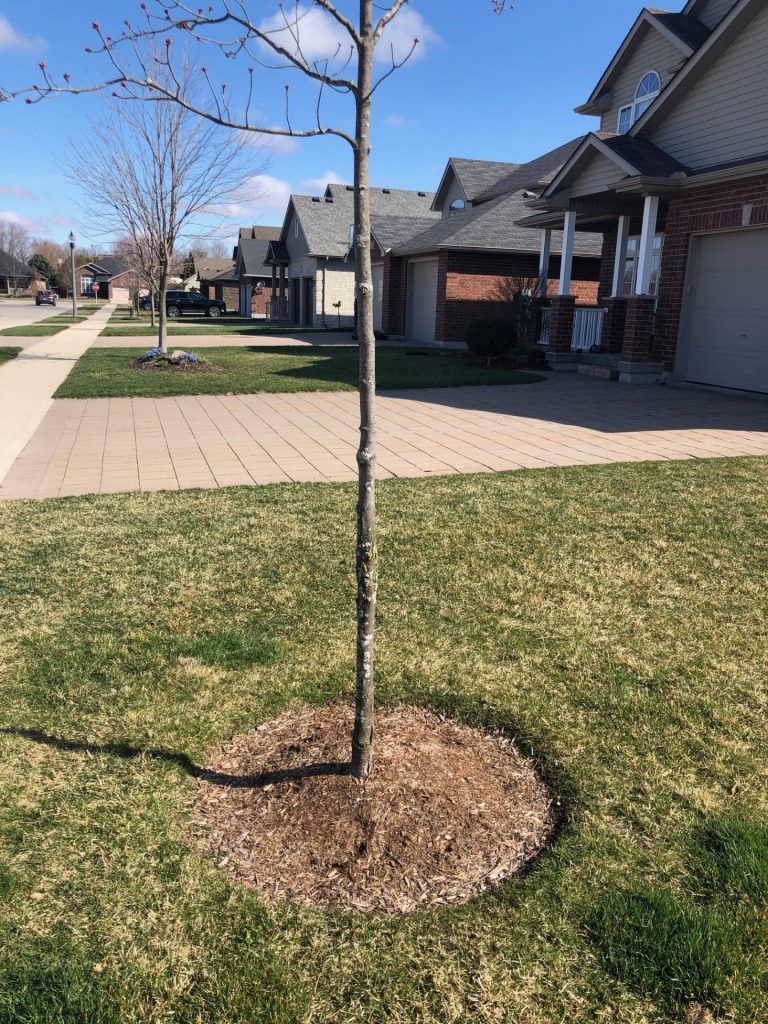
I live in SW Ontario. The tree in the attached photo is about 13 years old and is covered with what looks like a mold or a disease (my neighbour’s opinion). The other trees on my street are very mature with thick, healthy trunks and full branches. All neighbourhood trees were planted at the same time. My tree is blooming right now (the attached pic is a week old) while the others in the area are just budding. Mine will shed it’s leaves in late August/early September. It’s a typical subdivision with more sand than clay. I fertilize the tree twice / year and keep it hydrated during hot summers. My yard has a streetlight that used to provide full 360 degree but a few years ago they changed the streetlights and now the light shines out into the street vs my yard. Any guidance you can provide on what the issue is and how I can make this tree healthy would be very much appreciated. Thanks for your time. Stay safe!
MJ
Thank you for contacting the Toronto Master Gardeners.
Without a close up of the trunk it is difficult for me to tell you exactly what is groing on your tree. It could be that you have lichen growing on your tree. Lichen will develop in humid, damp, still conditions. They are not harmful at all to the plant but they may be an indication of poor plant vigour. They are more common on slow growing plants or older plants that are no longer growing at a vigorous rate. The side of a tree facing the rain and prevailing wind will often be affected by moisture loving lichens.
The link below provides more information on lichens and can help you confirm that the growths you are seeing on your trees are indeed lichens. https://njaes.rutgers.edu/fs1205/
Do you see any cracks in the bark? According to the Missouri Botanical Gardens, cracks and splits most often occur due to cold temperatures. These frost cracks occur when the inner and outer wood in the tree’s trunk expands and contracts at different rates when the temperature changes. This type of bark-splitting is thought to result from very cold temperatures on sunny winter days and is often associated with southwest exposure. On bright sunny days the southwest side of the tree heats up, absorbing the heat of the sun. When the sun sets or goes behind a cloud, there is a sudden freezing of the warm tissue. This sun scald results in the death of the exposed bark. The result is a vertical fissure down the center of the tree trunk, causing strips of bark to peel off, exposing the tree’s inner wood. Frost cracks may cause stress for your tree and provide a point of entry for pests and diseases. Damage from sunscald injury may eventually heal. Do you see any secondary cracks near the base of the treewhich could have been the result of mechanical or wildlife damage?
Another problem could be that the tree was originally planted too deeply. Take a look at the trunk of the tree. Every tree has a flare near the bottom where the trunk widens right before the roots begin. It is very important that the entire flare of the trunk is above the level of the soil. If it is below the level of the soil it will break down the bark and eventually kill the tree. if the tree is too deep you will need to dig around the tree and raise it up.
Girdling roots could be another issue. Look around the base of the root flare and make sure there are no roots growing around the trunk if so the root can grow around the trunk squeezing it. It is best to remove any girdling roots.
When you water, have the water run slowly for for a long period of time. If you run the water for at least an hour the water will be able to soak down into the roots. Let the soil dry out before you re-water. You may find you are watering less often but the tree will do better. Small amounts of water do not make it down to the roots. With evaporation, run off and grass etc. competing for the water very little if any will make it to the roots. Adding compost yearly to improve soil quality as well as application of mulch to help retain moisture and regulate soil temperature will also improve the overall health of the tree. Planting a Tree: Toronto Master Gardeners Gardening Guide gives additional information.
Lastly, you may wish to consult a certified arborist for a second opinion. The Ontario chapter of the International Society of Arboriculture’s website can help you to locate a qualified arborist in your area: https://www.isaontario.com/

